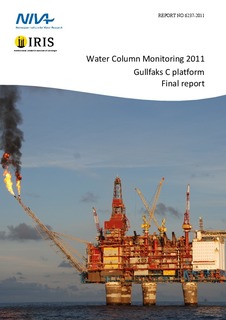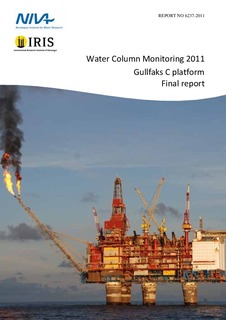| dc.contributor.author | Brooks, Steven | nb_NO |
| dc.contributor.author | Pampanin, Damiela N. | nb_NO |
| dc.contributor.author | Harman, Christopher | nb_NO |
| dc.contributor.author | Sundt, Rolf C. | nb_NO |
| dc.contributor.other | Brooks, S. - Project manager | nb_NO |
| dc.date.accessioned | 2014-08-01T10:56:44Z | |
| dc.date.available | 2014-08-01T10:56:44Z | |
| dc.date.issued | 2011 | nb_NO |
| dc.identifier | 6237 | nb_NO |
| dc.identifier.isbn | 978-82-577-5972-8 | nb_NO |
| dc.identifier.issn | 1894-7948 | nb_NO |
| dc.identifier.uri | http://hdl.handle.net/11250/215643 | |
| dc.description.abstract | The report presents results from the Water Column Monitoring survey 2011, performed in collaboration by NIVA and IRIS. The objective of the survey was to assess the extent to which produced water (PW) discharged from Gullfaks C platform affects organisms living in the water column. The study was designed to monitor bioaccumulation and biomarker responses in mussels held in cages in the vicinity of the water discharge point, with supporting information from passive sampling devices. Significantly greater bioaccumulation of PAH and NPD compounds was found in mussels from the two stations positioned 500 m from the platform, with concentrations significantly higher in mussels from one of the 500 m stations (i.e. station 2). All other mussel stations positioned 1000 m and 2000 m from the platform had PAH-NPD bioaccumulation typical of offshore background concentrations. There was very good agreement between the biomarker responses and the chemical concentration data. The calculated integrated biological response (IBR/n) was markedly higher in mussels from station 2, indicating poorer health. The IBR/n was also slightly raised in mussels from station 3 (1000 m), which was considered to be due to other chemicals within the PW. Alkyl phenols and naphthenic acids were detected in all POCIS placed at selected mussel stations from 500 to 2000 m, with mussel station 2 (500 m) and 3 (1000 m) showing highest concentrations of these compounds. PAH metabolites were detected in wild caught whiting (Merlangius merlangus) and tusk (Brosme brosme). The measured PAH metabolites in both fish species were indicative of weathered PW chemicals. Overall chemical bioaccumulation and impaired health to caged mussels was observed in mussels exposed to the PW plume located 500 m downstream from the platform. | nb_NO |
| dc.description.sponsorship | Statoil on behalf of the OLF WCM coordination group | nb_NO |
| dc.publisher | Norsk institutt for vannforskning | nb_NO |
| dc.relation.ispartofseries | NIVA-rapport;6237 | nb_NO |
| dc.rights | Navngivelse-IkkeKommersiell-DelPåSammeVilkår 3.0 Norge | nb_NO |
| dc.rights.uri | http://creativecommons.org/licenses/by-nc-sa/3.0/no/ | nb_NO |
| dc.subject | ecotoxicology | nb_NO |
| dc.title | Water Column Monitoring 2011 | nb_NO |
| dc.type | Research report | nb_NO |
| dc.rights.holder | Norsk institutt for vannforskning/Norwegian institute for water research | nb_NO |
| dc.subject.nsi | VDP::Matematikk og naturvitenskap: 400 | nb_NO |
| dc.source.pagenumber | 61 | nb_NO |
| dc.subject.keyword | biomarkører | nb_NO |
| dc.subject.keyword | produsert vann | nb_NO |
| dc.subject.keyword | blåskjell | nb_NO |
| dc.subject.keyword | overvåking | nb_NO |
| dc.subject.keyword | biomarkers | nb_NO |
| dc.subject.keyword | produced water | nb_NO |
| dc.subject.keyword | mussels | nb_NO |
| dc.subject.keyword | monitoring | nb_NO |
| dc.relation.project | 11208 | nb_NO |


